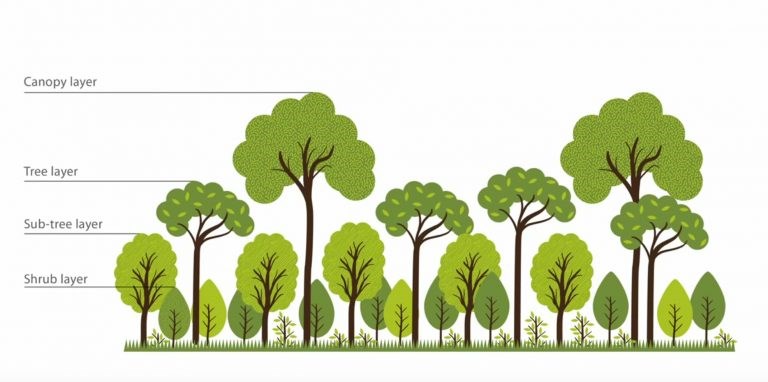About 60 years ago, the Japanese botanist Akira Miyawaki studied nature conservation and restoration in Germany. Miyawaki’s subsequent work in the field changed our concept of how to grow dense urban forests and restore biodiversity on even the smallest sites. His approach has become known as the Miyawaki method.
What are the advantages of the Miyawaki method? Compared to a conventional forest, speed of growth is multiplied by 10, density by 30, and biodiversity by 100.
What’s involved? At least 30 (more is better) native species of trees and shrubs of varying heights are planted close together, about three per square metre. The ground is prepared with a very deep layer of local organic matter, and once planted, it’s mulched to insulate it. For the first two years the site needs to be watered, but after that, it takes care of itself.
According to the eco-engineer Shubendu Sharma (who gave a TED talk on the Miyawaki method in Vancouver in 2014), “By making a multi-layered forest, we can fill up an entire vertical space with greenery.” It’s important to have the forest grow as a series of layers, Sharma states – a shrub layer (grows to approximately two metres), a sub-tree layer (approximately eight metres in height), a tree layer (around 12 metres) and a canopy layer (above 12 metres).
The oldest Miyawaki forest, planted 40 years ago, is in Yokohama, Japan. There are more in India and Malaysia. Recently Europe has become very interested in the benefits of such urban pocket forests. In 2015 the first “tiny forests” were planted in the Netherlands, and there are currently about 100 throughout the country. Belgium and France are also on track. Belgium started in 2016, with 60 volunteers planting 300 trees in the village of Ormeignies, in southern Belgium. France followed in 2017, when 30 volunteers planted 300 trees in Condé-sur-L’Escaut, near the Belgian border. More ambitious projects followed. In Belgium, there are now 20 Miyawaki forests, with trees ranging in number from 300 to 6,000. France, between 2019-2020, added seven Miyawaki forests, with between 600 and 2,175 trees.
The Miyawaki method has also taken root in the United States. In the fall of 2016, 60 volunteers planted 2,670 seedlings on a former horse pasture in the Audubon Greenway in western Pennsylvania.
Canada has yet to follow suit. Richmond is sending out a strong message that it’s concerned about “planting trees to grow the urban forest and clean the air.” But the trees being planted (for instance at McCallan Park and the Railway Greenway) are few, spaced far apart and unlikely to contribute much to biodiversity.
Isn’t it time we, too, give the Miyawaki method a try? Richmond could become the first place in Canada to grow such a pocket forest. We even have someone who’s studied the technique and is eager to put it into practice: Bruno Vernier, permaculturist, one of the directors of the Garden City Conservation Society ([email protected]).
Richmond, don’t you think the time’s come to be truly outstanding?
Sabine Eiche is a local writer and art historian with a PhD from Princeton University. She is passionately involved in preserving the environment and protecting nature. Her columns deal with a broad range of topics and often include the history (etymology) of words in order to shed extra light on the subject.



